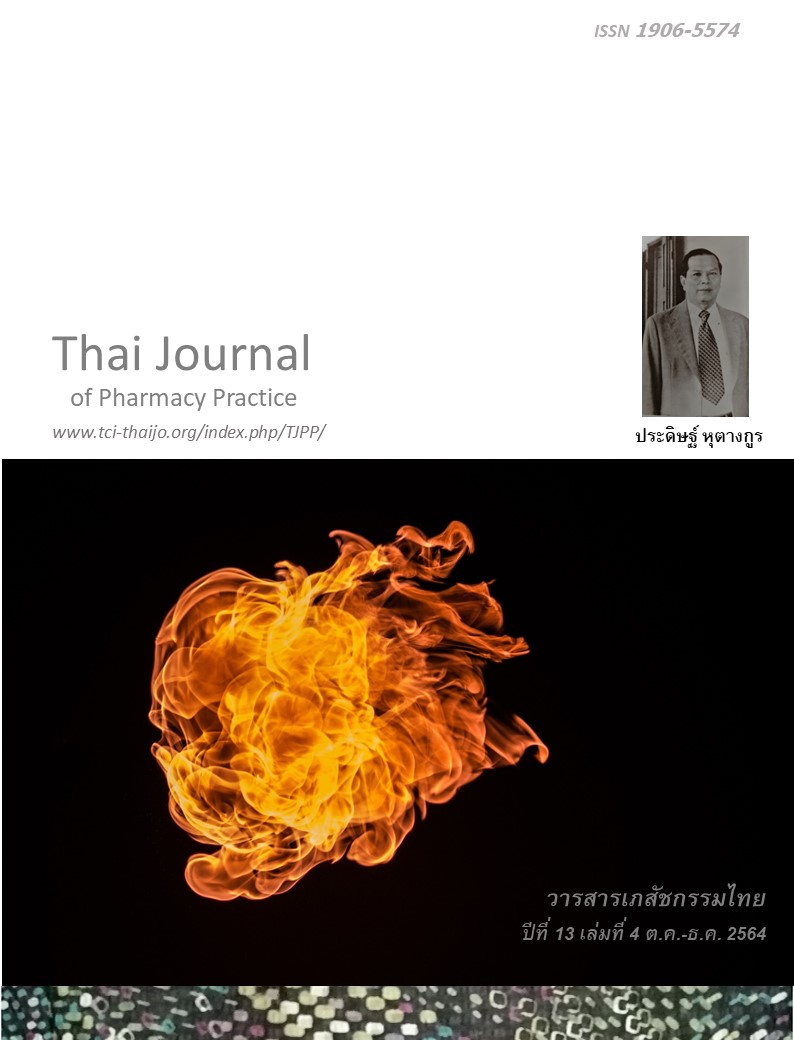การพัฒนาเกณฑ์ประเมินความเสี่ยงต่อการปนเปื้อนสารห้ามใช้ ที่เป็นอันตรายในเครื่องสำอางสำหรับผิวหน้า
Main Article Content
บทคัดย่อ
วัตถุประสงค์: เพื่อพัฒนาเกณฑ์ประเมินความเสี่ยงต่อการปนเปื้อนสารห้ามใช้ที่เป็นอันตราย (contamination with hazardous substances: CHS) ในเครื่องสำอางสำหรับผิวหน้าสำหรับผู้บริโภคเพื่อนำไปใช้เป็นแนวทางในการคุ้มครองตนเองจากการเลือกบริโภคเครื่องสำอางที่ปลอดภัย และสำหรับพนักงานเจ้าหน้าที่เพื่อนำไปใช้ในการเฝ้าระวังสถานการณ์ CHS วิธีการวิจัย: การวิจัยเชิงวิเคราะห์แบบภาคตัดขวางครั้งนี้ทำการศึกษาในเครื่องสำอางสำหรับผิวหน้าที่จำหน่ายในพื้นที่เทศบาลเมืองปากพนัง จังหวัดนครศรีธรรมราช จำนวน 210 ตัวอย่าง การศึกษาวิเคราะห์ปัจจัยที่สัมพันธ์กับ CHS ด้วยสถิติ logistic regression เพื่อสร้างสมการถดถอยทำนายโอกาสพบ CHS การวิเคราะห์ทำให้ได้เกณฑ์ประเมินความเสี่ยงสำหรับพนักงานเจ้าหน้าที่และสำหรับผู้บริโภคซึ่งตัดปัจจัยบางตัวที่อาจยากแก่ผู้บริโภคในการประเมินออก การศึกษาทดสอบความสามารถของเกณฑ์ฯ ด้วยการวิเคราะห์โค้ง ROC (receiver operating characteristics) ผลการวิจัย: สถานที่จำหน่ายเครื่องสำอางร้อยละ 72.34 จำหน่ายเครื่องสำอางที่แสดงฉลากไม่ถูกต้อง/ไม่แสดงฉลาก หรือเครื่องสำอางหมดอายุหรือเสื่อมสภาพ หรือเครื่องสำอางอันตรายตามประกาศกระทรวงสาธารณสุข จากตัวอย่างเครื่องสำอาง 210 ตัวอย่างพบ CHS 127 ตัวอย่าง (ร้อยละ 60.48) เครื่องสำอางที่แสดงฉลากถูกต้องพบ CHS ร้อยละ 31.03 และที่แสดงฉลากไม่ถูกต้อง/ไม่แสดงฉลากพบ CHS ร้อยละ 71.71 ปัจจัยที่มีความสัมพันธ์กับ CHS อย่างมีนัยสำคัญทางสถิติ จำนวน 7 ปัจจัย ได้แก่ ฉลากทำให้เข้าใจผิดในสาระสำคัญของเครื่องสำอาง แหล่งจำหน่าย (ตลาดสด ตลาดนัด หรือแผงลอย) การมีข้อบ่งใช้สำหรับรักษาสิว การไม่แสดงเลขที่ใบรับจดแจ้ง การไม่ระบุเลขที่หรืออักษรแสดงครั้งที่ผลิต การไม่ระบุที่ตั้งของผู้ผลิต/ผู้นำเข้า และการแสดงเลขที่ใบรับจดแจ้งปลอมหรือถูกยกเลิกเลขที่ใบรับจดแจ้ง เกณฑ์ประเมินความเสี่ยงต่อ CHS สำหรับพนักงานเจ้าหน้าที่ซึ่งพัฒนาขึ้นมีพื้นที่ใต้โค้ง ROC เท่ากับร้อยละ 84.80 (95% CI 79.70-90.00) กลุ่มที่มีระดับความเสี่ยงน้อย (คะแนน 0.0- 3.0 ปานกลาง (คะแนน 3.5 – 9.0) และสูง (คะแนน 9.5-11.5) มีค่า LR เท่ากับ 0.08 (95% CI 0.03-0.20), 1.06 (95% CI 0.80-1.41) และ 9.31 (95% CI 3.51-24.70) ตามลำดับ โดยพบ CHS ในตัวอย่างร้อยละ 11.36, 61.90 และ 93.44 ตามลำดับ ส่วนเกณฑ์ประเมินความเสี่ยงสำหรับผู้บริโภคที่พัฒนาขึ้นทั้ง 3 แบบมีพื้นที่ใต้โค้ง ROC เท่ากับร้อยละ 81.20-83.60 (95% CI 75.30-89.10) โดยมีค่าความไวร้อยละ 82.70-85.80 และความจำเพาะร้อยละ 65.10-67.50 สรุป: เกณฑ์ประเมินความเสี่ยง CHS ในเครื่องสำอางสำหรับผิวหน้าสามารถทำนายโอกาสพบ CHS ได้ดี ทั้งยังมีค่าความไวและความจำเพาะที่เหมาะสมแม้ว่าจะตัดปัจจัยบางตัวที่อาจยากแก่ผู้บริโภคในการประเมินออก ผู้บริโภคจึงสามารถใช้เกณฑ์ฯ ดังกล่าวเพื่อเป็นแนวทางในการเลือกซื้อเครื่องสำอางที่ปลอดภัย พนักงานเจ้าหน้าที่ยังสามารถใช้เกณฑ์ฯ ดังกล่าวสำหรับเฝ้าระวังสถานการณ์ CHS ในเครื่องสำอางได้
Article Details
ผลการวิจัยและความคิดเห็นที่ปรากฏในบทความถือเป็นความคิดเห็นและอยู่ในความรับผิดชอบของผู้นิพนธ์ มิใช่ความเห็นหรือความรับผิดชอบของกองบรรณาธิการ หรือคณะเภสัชศาสตร์ มหาวิทยาลัยสงขลานครินทร์ ทั้งนี้ไม่รวมความผิดพลาดอันเกิดจากการพิมพ์ บทความที่ได้รับการเผยแพร่โดยวารสารเภสัชกรรมไทยถือเป็นสิทธิ์ของวารสารฯ
เอกสารอ้างอิง
Cosmetic Control Group, United States Department of Commerce. Thailand - personal care and beauty products [online]. 2017 [cited Oct 6, 2017]. Available from: www.export.gov/article?id=Thailand -personal-care-and-beauty-products.
Office of the consumer protection board. Annual report 2014 - 2015 [online]. 2017 [cited Oct 5, 2017]. Available from: www.ocpb.go.th/more_news. php?cid=20.
Health product vigilance center, Ministry of Public Health. Annual report 2014 - 2016 [online]. 2017 [cited Oct 5, 2017]. Available from: thaihpvc.fda.mo ph.go.th/thaihvc/Public/Webpage/main.jsp.
Sukamolson S, Sriviriyanuparp W, Kulsomboon V. Priority, prevalence and geographic distribution of unsafe products in Thailand. Journal of Health Systems Research 2016; 10: 65-79.
Bureau of Cosmetics and Hazardous Substances, Department of Medical Sciences. Annual report 2015 [online]. 2017 [cited Oct 5, 2017]. Available from: webapp1.dmsc.moph.go.th/itc/annual_report/ pdf/2558/58-cosmetics.pdf.
Cosmetic Act B.E. 2558. Royal Gazette No. 132, Part 86A (Sep 8, 2015).
Boonprachom A, Yukittichai N, Ekkabut N, Pongni mitprasert N, Nuntharatanapong N. Investigation of ammoniated mercury and hydroquinone in whitening creams distributed in Amphur Muang Nakhon Pathom province. Thai Bulletin of Pharma ceutical Sciences 2013; 8: 1-8.
Singchongchai P. Principles and using multivariate statistics analysis for nursing research. 3rd ed. Songkhla: Chanmuang Press; 2006.
Prasongkool K, Ruengorn C. Analysis of the situation on contamination of prohibited harmful substances in facial cosmetics in Amphur Nangrong, Buriram province during 2013-2016. Thai Journal of Phar macy Practice 2017; 9: 361-9.
Klinsoonthorn N, Nutsatapana C, Khemthong T, Mapradit P. Prohibited substances in acne melasma whitening cosmetic products in lower central provinces during 2010-2013. FDA Journal 2013; 20: 28-36.
Karimollah HT. Sample size estimation in diagnostic test studies of biomedical informatics. J Biomed Inform 2014; 48: 193-204.
Kumar R, Indrayan A. Receiver operating charac teristic (ROC) curve for medical researchers. Indian J Pediatr 2011; 48: 277-86.
Hosmer DW, Lemeshow S. Applied logistic regres sion. 2nd ed. New York: A Wiley-Interscience Publi- cation; 2000.
Iamprakhon B. A Proposed method to compare areas under the ROC curves for a single dataset: A case study of credit scoring model [master thesis]. Bangkok: Chulalongkorn University; 2017.
Srisawad S. The predictive accuracy and optimal cut point of citation-based journal metrics to number of citations on Scopus nursing journals: comparison between SJR Indicator and citations per document. TLA Research Journal 2018; 11: 30-44.
Akobeng AK. Understanding diagnostic tests 2: likelihood ratios, pre- and post-test probabilities and their use in clinical practice. Acta Paediatr 2006; 96: 487-91.
Ruengorn C, Nanta S. Steps for developing a screening tool by using clinical prediction rules: a case study from a screening tool for attempted suicide in bipolar patients. Bulletin of Suanprung 2015; 31: 56-71.
Wutthiadirek W, Poomkat W. Study of mercury levels in facial creams distributed in Nakhonsawan municipality area. FDA Journal 2016; 23: 28-33.
Thongsookdee S, Nooda N, Worapranee T. Situation and management of cosmetic safety in Sukhothai province. FDA Journal 2018; 25: 61-71.


